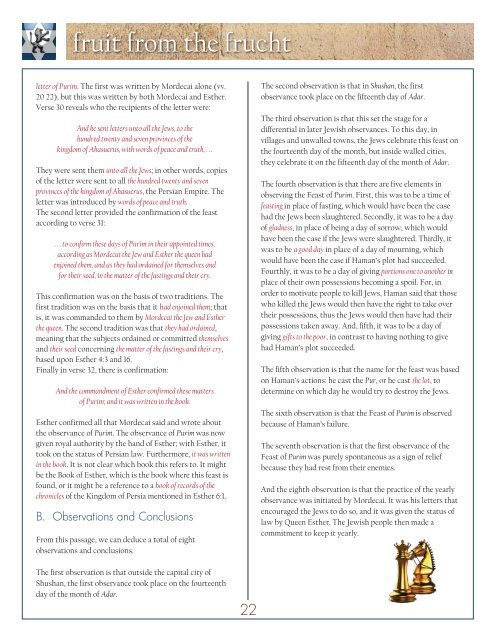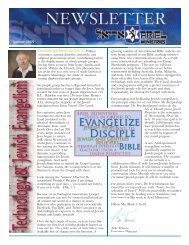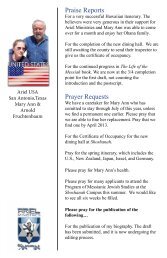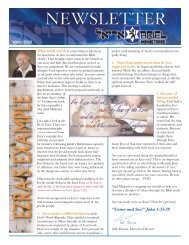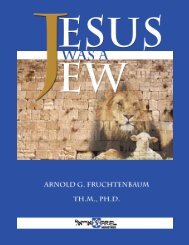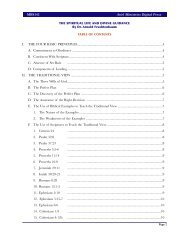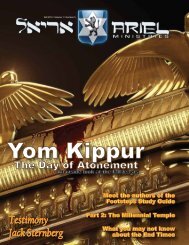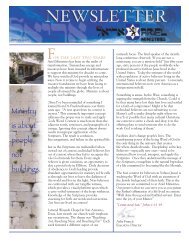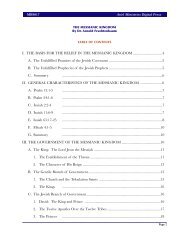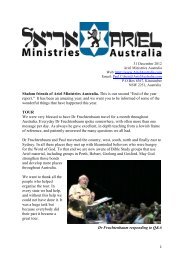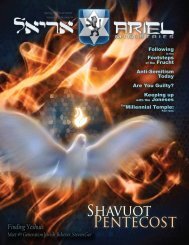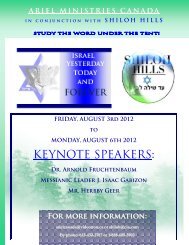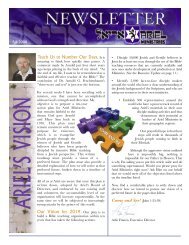Ariel Magazine Purim Edition Cover copy - Ariel Ministries
Ariel Magazine Purim Edition Cover copy - Ariel Ministries
Ariel Magazine Purim Edition Cover copy - Ariel Ministries
You also want an ePaper? Increase the reach of your titles
YUMPU automatically turns print PDFs into web optimized ePapers that Google loves.
fruit from the frucht<br />
letter of <strong>Purim</strong>. The first was written by Mordecai alone (vv.<br />
20 22), but this was written by both Mordecai and Esther.<br />
Verse 30 reveals who the recipients of the letter were:<br />
And he sent letters unto all the Jews, to the<br />
hundred twenty and seven provinces of the<br />
kingdom of Ahasuerus, with words of peace and truth, . . .<br />
They were sent them unto all the Jews; in other words, copies<br />
of the letter were sent to all the hundred twenty and seven<br />
provinces of the kingdom of Ahasuerus, the Persian Empire. The<br />
letter was introduced by words of peace and truth.<br />
The second letter provided the confirmation of the feast<br />
according to verse 31:<br />
. . . to confirm these days of <strong>Purim</strong> in their appointed times,<br />
according as Mordecai the Jew and Esther the queen had<br />
enjoined them, and as they had ordained for themselves and<br />
for their seed, in the matter of the fastings and their cry.<br />
This confirmation was on the basis of two traditions. The<br />
first tradition was on the basis that it had enjoined them; that<br />
is, it was commanded to them by Mordecai the Jew and Esther<br />
the queen. The second tradition was that they had ordained,<br />
meaning that the subjects ordained or committed themselves<br />
and their seed concerning the matter of the fastings and their cry,<br />
based upon Esther 4:3 and 16.<br />
Finally in verse 32, there is confirmation:<br />
And the commandment of Esther confirmed these matters<br />
of <strong>Purim</strong>; and it was written in the book.<br />
Esther confirmed all that Mordecai said and wrote about<br />
the observance of <strong>Purim</strong>. The observance of <strong>Purim</strong> was now<br />
given royal authority by the hand of Esther; with Esther, it<br />
took on the status of Persian law. Furthermore, it was written<br />
in the book. It is not clear which book this refers to. It might<br />
be the Book of Esther, which is the book where this feast is<br />
found, or it might be a reference to a book of records of the<br />
chronicles of the Kingdom of Persia mentioned in Esther 6:1.<br />
B. Observations and Conclusions<br />
From this passage, we can deduce a total of eight<br />
observations and conclusions.<br />
The second observation is that in Shushan, the first<br />
observance took place on the fifteenth day of Adar.<br />
The third observation is that this set the stage for a<br />
differential in later Jewish observances. To this day, in<br />
villages and unwalled towns, the Jews celebrate this feast on<br />
the fourteenth day of the month, but inside walled cities,<br />
they celebrate it on the fifteenth day of the month of Adar.<br />
The fourth observation is that there are five elements in<br />
observing the Feast of <strong>Purim</strong>. First, this was to be a time of<br />
feasting in place of fasting, which would have been the case<br />
had the Jews been slaughtered. Secondly, it was to be a day<br />
of gladness, in place of being a day of sorrow, which would<br />
have been the case if the Jews were slaughtered. Thirdly, it<br />
was to be a good day in place of a day of mourning, which<br />
would have been the case if Haman’s plot had succeeded.<br />
Fourthly, it was to be a day of giving portions one to another in<br />
place of their own possessions becoming a spoil. For, in<br />
order to motivate people to kill Jews, Haman said that those<br />
who killed the Jews would then have the right to take over<br />
their possessions, thus the Jews would then have had their<br />
possessions taken away. And, fifth, it was to be a day of<br />
giving gifts to the poor, in contrast to having nothing to give<br />
had Haman’s plot succeeded.<br />
The fifth observation is that the name for the feast was based<br />
on Haman’s actions: he cast the Pur, or he cast the lot, to<br />
determine on which day he would try to destroy the Jews.<br />
The sixth observation is that the Feast of <strong>Purim</strong> is observed<br />
because of Haman’s failure.<br />
The seventh observation is that the first observance of the<br />
Feast of <strong>Purim</strong> was purely spontaneous as a sign of relief<br />
because they had rest from their enemies.<br />
And the eighth observation is that the practice of the yearly<br />
observance was initiated by Mordecai. It was his letters that<br />
encouraged the Jews to do so, and it was given the status of<br />
law by Queen Esther. The Jewish people then made a<br />
commitment to keep it yearly.<br />
The first observation is that outside the capital city of<br />
Shushan, the first observance took place on the fourteenth<br />
day of the month of Adar.<br />
22


